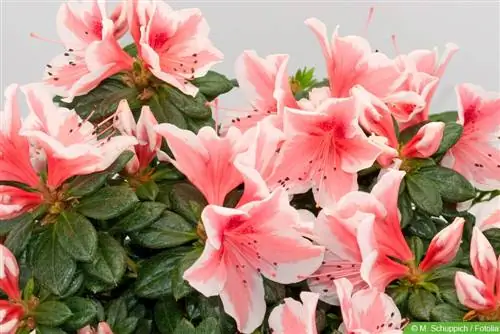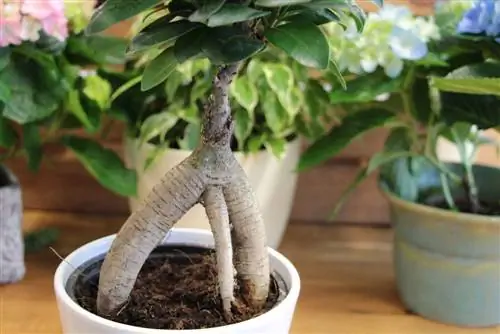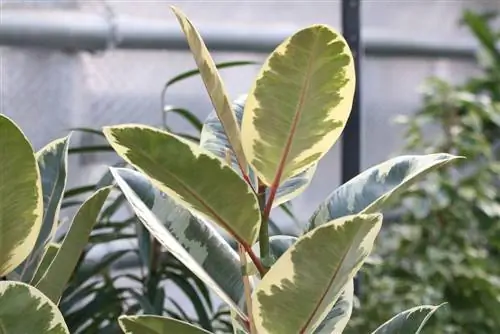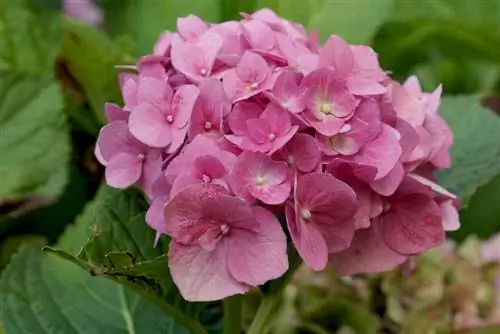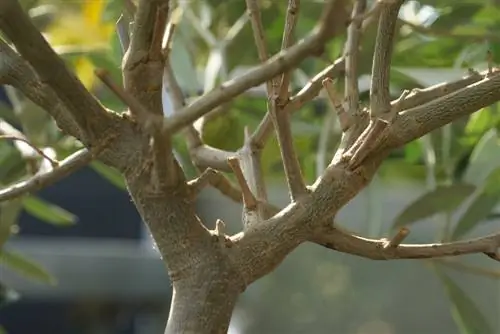- Author admin [email protected].
- Public 2023-12-17 03:39.
- Last modified 2025-06-01 06:48.
The indoor azalea is a grateful and relatively undemanding plant. It grows as a small flowering shrub with heights and widths of up to 45 cm. This plant is closely related to the rhododendron. It also retains its dark green foliage all year round. However, under unfavorable conditions regarding care and location, it can happen that it loses all or part of it.
Azaleas - popular houseplants for winter and spring
As houseplants, azaleas are primarily kept as winter and spring bloomers; they are among the most beautiful winter bloomers. When purchasing these small, densely branched shrubs, you should pay attention to a few things to avoid bringing sick plants into your home. The Federal Association of German Gardeners (BDG) advises that the leaves should be fresh green and not curled and that the color of the flowers should be visible on at least half of the buds.
If the plant makes a good impression, nothing stands in the way of buying it. When cultivating these plants, it is then important to take into account their natural requirements for climatic conditions and care and to do justice to them as best as possible. Otherwise, the indoor azalea may lose one or two leaves, which can have various causes.
Water shortage
The most common cause of premature leaf loss is lack of water. This applies to indoor azaleas as well as specimens in the garden. Azaleas are ericaceous plants, which means that their roots always want to be moist. If the soil is dry for a long time, both leaves and buds fall off. Lack of water is reflected in colorless flowers and limp, dry leaves.
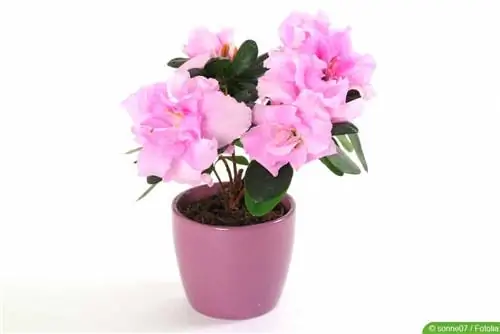
It means that the roots can only absorb a little potassium, so the azalea pulls it out of the leaves. As a result, they turn brownish from the tip. As the soil gradually dries out, they take on a yellowish color before eventually falling from the plant. If, on the other hand, an abrupt deficiency occurs, the plant also sheds green leaves. The soil dries out particularly quickly in the pot, especially if the pot is too small. As a rule, a lack of water can be easily remedied.
- If there has been a lack of water for a long time, water the plant and pot thoroughly
- In a container with lukewarm, soft water for at least 20 minutes
- Water regularly later
- Soaking baths at regular intervals, better than watering
- Always submerge the plant until no more bubbles appear
- Afterwards let the water drain well
- Empty coasters and planters shortly after watering
- Make sure planters are large enough
Tip:
Although the azalea needs plenty of water, it cannot tolerate waterlogging, as this inevitably leads to root rot.
Temperatures too high
The flowering period of these plants falls in the winter months, when the house is heated to a greater or lesser extent. Then finding a suitable location is difficult. Due to its natural origin, the cool and moist mountain forests of East Asia, the indoor azalea prefers cooler temperatures. What it also cannot tolerate is direct sunlight. It causes burn marks on the leaves and they fall off.
The ideal temperature is between 18 and 20 degrees. If it is warmer than 21 degrees, the flowers wilt relatively quickly and the fresh green foliage also falls off. An equally big challenge is that the humidity in living spaces is usually too low. But there are ways to reduce the risk of leaf loss due to heat and lack of humidity.
- Place the plant permanently in a cooler place
- Or slowly get used to the climatic conditions in the house
- It's best to start immediately after purchase
- First place the azalea in a slightly heated, bright to semi-shady place
- It is essential to avoid direct sunlight and midday sun
- For example, a staircase, bedroom window or winter garden
- After about three days move to a slightly warmer location
- Temperatures should not exceed 20 degrees
- Bright to partially shaded location with high humidity is optimal
- Best in front of an east or west facing window
- Over the summer, also in the garden
- Spray the plant occasionally with soft water
Tip:
It is not advisable to place it directly above the heater. Here buds, flowers and foliage would dry out quickly.
Diseases
There are various diseases that cause azalea leaf loss.
Branch dying
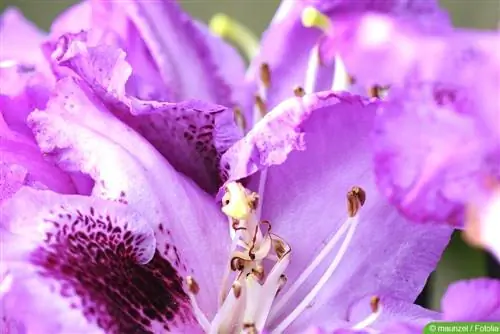
Leaf loss can also be the result of a fungal infection. What is meant is the so-called branch dieback. The infection usually begins on the terminal buds, which turn brown. Brown spots can later be seen on the leaf midribs. The individual leaf curls up and the plant sheds it. All branches with corresponding leaf spots must be cut out, because the azalea can only be saved if all diseased shoots are completely removed.
Tip:
You can sometimes recognize a possible infection on branches with dull leaves. They can be an indication that the fungus has already established itself.
Nitrogen deficiency
If this attractive plant loses its foliage, it could also be due to a nitrogen deficiency. Initially only older leaves turn light green to yellowish. If action is not taken soon, the same thing will happen to young leaves. The plant only produces a few buds and drops leaves.
Appropriate nitrogen fertilization can help. If these symptoms occur despite regular fertilization, it may be that the substrate is too compacted. In this case, it is important to immediately repot the plant into a more airy substrate. Then add some liquid fertilizer to a bucket of water and place the plant in it until the ball has absorbed water well. Then let them drain well.
Chlorosis
If the plant is affected by chlorosis (iron deficiency), this manifests itself in brown leaf edges, stunted growth, yellowing and leaf fall. The disease is often caused by a high lime content in the soil and/or irrigation water. Lime ensures that the chlorophyll responsible for the green color is not formed properly or is even broken down.
As already mentioned, the indoor azalea is a ericaceous plant and is therefore sensitive to lime. Repeated watering with hard water makes the problem worse because the pH value in the soil continues to rise. To lower it again, it is advisable to repot the azalea in ericaceous or rhododendron soil. Otherwise, careful treatment with special iron preparations in the form of iron fertilizer or foliar fertilizer for spraying may be recommended.
Tip:
Chlorosis can also be caused by waterlogging, constant lack of water or mineral fertilizers. It can affect indoor azaleas but also azaleas in the garden.

